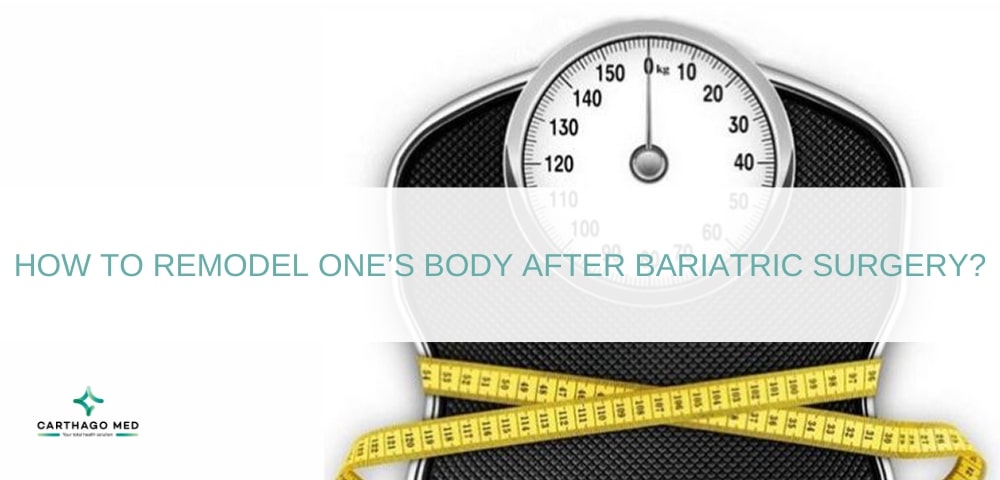
plastic surgery after bariatric surgery
HOW TO REMODEL ONE’S BODY AFTER BARIATRIC SURGERY?
Bariatric surgery describes the different procedures that treat obesity like gastric band,gastric sleeve or gastric bypass.The decision to undergo such procedures is only assisted by the surgeon per se. Indeed, the latter will take into account the patient’s BMI (Body Mass Index), comorbidity, and alteration of life quality before indulging into any surgical act. Bariatric surgery should be resorted to as a final solution after the body has failed to respond to diets and other attempts of losing weight. The results of bariatric surgery, described in massive weight loss through the removal of fatty tissues, have heavy consequences on the patient’s figure. In addition, the unequal repartition of remaining fat will result in drooping and unaesthetic excess skin. After the results of bariatric become stable, the surgeon arranges consultations with their patient to deal with the sequela of massive weight loss.
What are the common aesthetic consequences of bariatric surgery-related weight loss?
Bariatric surgery often leads to significant weight loss, but it can also result in undesirable consequences for the body's appearance. One common issue is the development of excess, saggy skin in various areas. This loose skin is particularly prominent in the abdomen, both on the front and sides, making it aesthetically displeasing. Additionally, both male and female breasts may shrink and droop, and the buttocks can also lose their firmness, sagging in the process. The skin on the inner thighs and arms weakens, often requiring surgical lifting procedures to address these concerns. These sequelae of weight loss highlight the challenges individuals face in achieving their desired body image after undergoing bariatric surgery.
Which surgical options address aesthetic issues after bariatric surgery-induced weight loss?
Arm Lift or Brachioplasty
One of the most common areas where excess skin is noticeable is the upper arms. After significant weight loss, the upper arms can have hanging skin, often referred to as "bat wings." Arm lift, also known as brachioplasty, is a surgical procedure designed to remove this excess skin, providing a more toned and defined appearance to the arms. This procedure involves making incisions from the armpit to the elbow, allowing the surgeon to remove the loose skin and create a pleasing contour.
Breast lift or mastopexy
Breast lift, also known as mastopexy, is a popular procedure designed to address sagging breasts. During this surgery, excess skin is removed, and the breast tissue is reshaped to achieve a firmer and more youthful appearance. For individuals dealing with both loose skin and loss of breast volume, surgeons may opt for mastopexy in combination with breast augmentation using implants. This dual approach not only lifts the breasts but also restores their fullness, providing a natural and aesthetically pleasing result.
Stomach lift or abdominoplasty
Stomach lift or abdominoplasty is a popular procedure among individuals dealing with loose skin after bariatric surgery. This surgery involves the removal of excess skin and fat from the abdominal area, resulting in a tighter, more contoured midsection. The procedure is especially beneficial for those who struggle with the unsightly apron of skin hanging over the pubic region. Patients often opt for abdominoplasty to improve their body shape and enhance their overall self-confidence.
Lower Body Lift
One of the most effective procedures for addressing loose skin on the lower body is the lower body lift. This surgery targets multiple areas, including the buttocks, thighs, and abdomen. Patients who have undergone significant weight loss often find that their lower body is left with excess skin, which can cause discomfort and hinder their ability to enjoy their newfound healthier lifestyle.
Panniculectomy
Panniculectomy is a surgical procedure specifically designed to remove excess skin, particularly in the abdominal area, after significant weight loss. It is crucial for patients who have undergone bariatric surgery and are left with an overhanging panniculus, a large apron of skin hanging from the stomach that can cover the pubis and groin areas. This procedure not only improves the aesthetic appearance but also enhances the patient's overall comfort and confidence. During a panniculectomy, the surgeon makes careful incisions to remove the excess skin and create a more pleasing contour. For patients with a history of obesity, these procedures are life-changing, as they help in eliminating problems related to irritation, hygiene difficulties, and mobility issues caused by the loose, hanging skin.
Inner Thigh Lift and Outer Thigh Lift
After substantial weight loss, many individuals encounter the challenge of excess skin in their thigh area, which can lead to discomfort and hinder their ability to fully embrace their transformed bodies. To address these concerns, specialized procedures known as inner thigh lift and outer thigh lift have been developed, targeting these specific areas and providing patients with smoother, firmer thighs.
The inner thigh lift procedure is tailored to eliminate surplus skin from the inner thigh region. Skilled plastic surgeons carefully remove the loose skin, resulting in a more defined and toned appearance. This surgery is particularly beneficial for those who experience discomfort and chafing due to excess skin rubbing together. Conversely, the outer thigh lift procedure focuses on addressing loose skin on the outer thighs and buttocks. By strategically making incisions, surgeons remove the excess skin, enhancing the overall contour of the thighs and buttocks. Not only does this surgery improve physical appearance, but it also significantly boosts self-confidence, allowing individuals to fully embrace their transformed bodies with newfound assurance.
How Are Procedures Tailored to Patients for Minimized Manipulations and Hospitalizations?
The association of several procedures to minimize manipulations and hospitalizations is established in accordance with the patient’s case. Procedures differ depending on skin quality, lifestyle, degree of weight loss, gender, age, and areas of weight loss. However, the priority area is generally that of the abdomen. Breast surgery can either be associated with the latter or act as a second intervention that takes in charge other areas of the body. The principle of procedure repartition deems unfeasible to combine complex and long procedures together because the latter will result in heavy sequela and can be of risk to the patient’s health. Therefore, the decision regarding the number and repartition of procedures will constitute the subject of an agreement between the surgeon and the patient.
What are the results of remodel body after bariatric surgery?
Thanks to the aforementioned procedures, the patient’s body is harmoniously remodelled. The results of weight loss are finally visible and can be appreciated. Post-surgical scars are well-hidden in the natural folds of the body and under underwear. The latter are expected to fade away with time. Bariatric surgery is not a minor procedure as it involves several interventions, and may cause a lot of pain and discomfort. Therefore, the patient should be armed with patience in order to enjoy the final and stable results of the surgery.









